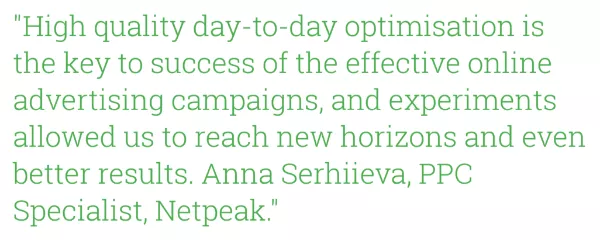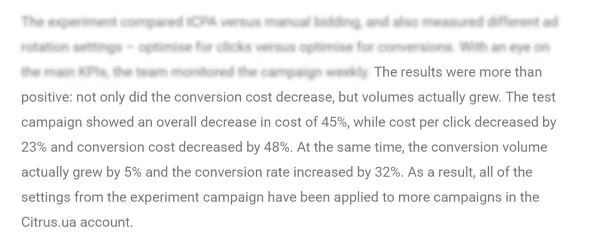How to write a case study: a guide for technicians based on Citrus and Netpeak case study in Google blog
Many specialists don’t like to write articles, let alone case studies. While they’re silent, internet is full of weak and flimsy publications. This guide is first of all designed for specialists who either underestimate their progress or can’t tell others about it.
Before revealing a secret of a case study Google blog may be interested in, let’s answer the key question.
Why do you need case studies?
I will give you several reasons, and you may choose the one that motivates you best.
1. Driving new clients
Case study form helps to illustrate the goals achievement path in an interesting and engaging way. It may become good branding both for you and your client’s business. For example, Citrus case study on Netpeak blog (RU) got almost 16 000 views and 471 reposts.
Google editors amplified and reposted our case study to their Russian, English and Turkish blogs. According to Similarweb, only English blog is monthly read by 6 500 000 users.
2. Developing market
Case studies work well when selling complex and innovative services. For example, case study of Citrus and Netpeak describes smart bidding and use of data-driven attribution. One can hardly find general information on this functionality on the internet, saying nothing of case studies with the open brand.
Netpeak specialists described the process of setting up experiments in AdWords:
Stories about using new products help to form the common work standards, provoke discussions and inspire other specialists.
3. Making own brand
Definitely, writing a case study will take more time than just making a report for a client. And performing short tasks will be more attractive. But don’t let the routine absorb you - one month later you won’t remember things that seem to be essential for you today. Unlike reports, case studies will work for your reputation for a long time.
Furthermore, case studies let accurately analyze how you led a project to success.
When to write a case study
I often come up against a situation where a specialist achieves perfect results within his project but sees nothing noteworthy in his work.
The collective expertise of your department, agency or any other professional group does not reflect a general level of knowledge at the market. For instance, some items included into standard checklists in Netpeak are often forgotten by other specialists and unknown by clients and newbies.
Write a case study if some items from the checklist below are true for your project:
- Solving widespread problems in non-standard ways.
- Obtaining perfect results by using a definite source or tool. A case study will be especially valuable if you describe a new tool or a tool underestimated by other specialists.
- Continually getting good results within a project, especially if the subjects are unordinary or highly competitive.
- Using work standards which are often underestimated by other market players.
How to create a really good case study
The process of writing a case study resembles that of launching advertising campaigns:
- you should understand the subject and the purpose of your case study;
- you should define your target audience and think of subjects unknown for your prospective readers;
- you should find the information and present it in a way interesting and easy-to-understand to your readers.
1. Allocate time for a case study.
The Citrus campaigns experiment article is one of the “fastest” case studies on our blog. Nevertheless, it took a month and a half to have it published (1,5 month from experiment start to the case study publication).
In figures:
- running an experiment and obtaining results - 4 weeks;
- writing a text - 1 week;
- agreeing it with a client - 1 week;
- editing and publishing - 3 days.
Plan your case study in advance and take into account the project seasonality.
2. Gather information
That’s when your daily reports and work correspondence came in. These are the sources of information you may use to recall the work process or just copy the items you need.
- project development strategy;
- work reports (current tasks and completed tasks, correspondence with a client, comments);
- advertising campaigns efficiency reports you’ve prepared for a client.
Give special attention to direct speech - any case study without it is almost dead.
Extract from our case study in Google blog:
3. Think of your case study structure
What would you like to focus your readers’ attention on? Describing all details is not always justified. Just choose key messages you want to convey:
- the problem you solved - goals and tasks. We had to reduce the cost of conversion in the Citrus case study;
- hypotheses and actions of your team. For example, setting up the experiment and testing two bidding strategies;
- promotion results and conclusions.
Don’t overload your case study with professionalisms and complex formulas. Make it simple if you want your article to be read by non-professionals as well.
Structure your conclusions, include figures and percentage. This will provide better perception of a text and let other authors, inspired by your case study, easily transform it without the facts distortion.
Citrus case study results on Netpeak blog (translated from Russian):
Results:
- cost per click decreased by 23%;
- expenses on promotion of advertising campaigns under test decreased by 45%;
- the number of transactions increased by 5%;
- transaction cost decreased by 48%;
- conversion rate increased by 32%.
Google blog post:
By the way, don’t be afraid to describe unsuccessful hypotheses and decisions if they helped you come to the right decision.
4. How to tell something you can’t tell
Predominantly, specialists are not allowed to disclose information on the client’s income, the number of driven leads and advertising budgets. Writing a case study without it is pointless. But still, you should respect the commercial secret of your client and hereby find ways to present results without definite figures. Providing data in percent or visualizing it can be a good way to write an interesting case study and not to disclose classified information at the same time.
Example from a video advertising case study:
Such diagrams show the growing dynamic but don’t disclose any classified information.
5. Promote your article
Advertising your article is important, but you should think of making contacts with representatives and organizations as well. Agencies have an advantage in this situation since the specialists may send a link to a case study right to Google managers. That’s what Netpeak specialists did.
Google managers volunteered to reformat the case study for their blog since the smart bidding subject is not popular yet, and the company is interested in spreading qualitative information about this tool.
How to overcome “the crisis of a genre”
Let’s imagine that you have already made up your mind to write a case study. You have even gathered information and worked out the general concept. But you’ll face many challenges ahead. Newbie authors often undergo the crisis right when they start writing (that very blank sheet fear) and when they receive amendments from an editor.
There are a lot of psychological tricks to focus on work. I will share the ones which help the authors of our blog.
1. Part your work
Definitely, writing a case study is time-consuming. Therefore, try to spend at least half an hour twice a week (for example, on Tuesday and on Thurthday) to write a text. So, when deadline comes, you will have some drafts, which is much better than writing a text over the last night.
2. Start describing the simplest item from your checklist
You don’t have to strictly follow your plan. If you don’t know what to start with, just describe the results of your work.
3. Criticize yourself
Just imagine: you open the document with a text draft and don’t know what to do next and don’t remember what you wanted to change or add. To avoid this situation, just leave comments for yourself.
Such small tasks help to gradually move to the main goal. They also let you realize how many text issues you have and how much time you need to fix them.
{tilda_form_wildcard_25148512}
Mind the ethics
1. Agree a text with a client.
When telling about the client’s goals and business processes, that’s very important not to disclose the commercial secret and not to destroy his confidence. You should always agree your text with the client.
2. Don’t tell you did all the work
If you cooperated with the client’s team and they did most of work, don’t be afraid to tell about it. If the cooperative actions of a strong team led to success, this is a sign of well-coordinated work of the contractor and the client as well as ability to find compromises.
3. Tell the truth
A lot of readers are skeptical about case studies with no brand name since the data reliability can’t be checked. Under these circumstances, the reputation of a specialist or a company he works at is of great importance. But still, text presentation affects the level of scepticism as well. If you use trite phrases and don’t provide details, your readers will have justified questions on your sincerity and honesty.
Key things to remember:
- Case studies help to sell your services, make your own brand and form a demand for it.
- If you have any success story, share it.
- Allocate time to write a case study, mind the subject seasonality.
- Think of benefits your case study may bring to other specialists and your potential clients.
- Visualize data if your project is under NDA.
- Don’t tell you did all the work. Ability to efficiently work with the client’s team is an important skill worth sharing.
- Promote your text.
- Be honest with your clients, readers and colleagues.
Related Articles
How to Set Up Consent Mode in GA4 on Your Website with Google Tag Manager
Let's explore how to properly integrate consent mode in GA4, configure it for effective data collection, and at the same time comply with GDPR and other legal regulations
Display Advertising Effectiveness Analysis: A Comprehensive Approach to Measuring Its Impact
In this article, I will explain why you shouldn’t underestimate display advertising and how to analyze its impact using Google Analytics 4
Generative Engine Optimization: What Businesses Get From Ranking in SearchGPT
Companies that master SearchGPT SEO and generative engine optimization will capture high-intent traffic from users seeking direct, authoritative answers











